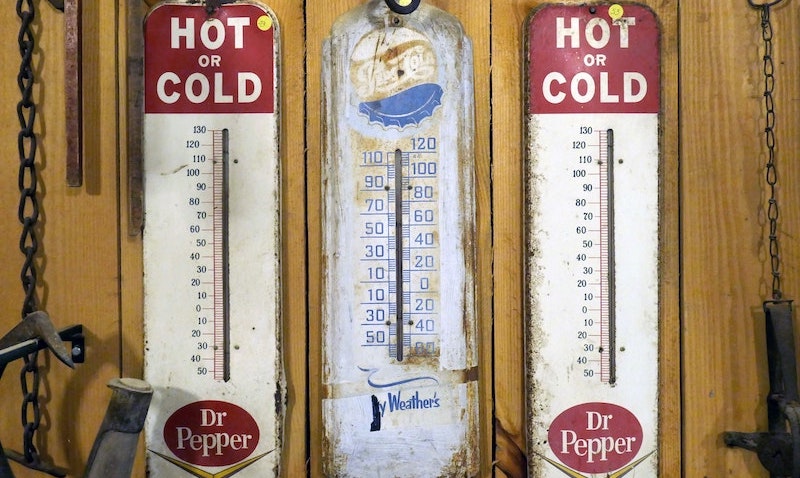BBQ and the science of the stall

If you have been in or around the low-and-slow BBQ community at all, you will likely be familiar with what is known as the stall. A dreaded, yet strangely respected, part of cooking any larger piece of meat at a lower temperature.
If you aren’t familiar with the stall and are planning your first big brisket, short rib, pork shoulder low-and-slow cook, then it might be worth reading up a bit on the phenomenon.
1. What is the stall?
Whilst cooking a large piece of meat, such as brisket or pork shoulder, low-and-slow, its common to observe the internal temperature of the meat stall. That is, the temperature might be increasing at a steady rate for the first few hours, then out of the blue, just stop. It can sit there, not changing in temperature (all whilst still in the BBQ) for hours, and in some cases it can actually decrease in temperature! This stalling can happen at varying temperatures but normally occurs whilst the internal temperature of your meat is somewhere in the range of 65-77 degrees centigrade (150-170F).
This flat-lining of temperature is known as the stall. What’s more, it can be a cruel beast. Sometimes, seemingly choosing not to appear at all, and other times arriving and refusing to leave for hours on end resulting in your cook not being ready until late into the night.
2. What causes the stall?
There have been many theories over the years as to what causes it, but there have since been experiments to prove that the stall is caused by evaporative cooling. This is the same thing that happens when humans sweat - the evaporation of sweat moisture from the skin cools us.
When the meat hits the stalling temperature range (65-77C/150-170F), the moisture from the surface is evaporating and cools the meat. In normal oven cooking (e.g. not low-and-slow), this isn’t an issue, as the degree to which this cools pales in comparison to the heat of a 180C oven. Indirect cooking in a grill at 110C(225F), on the other hand, is a low enough heat that the evaporative cooling is enough to counteract the heating from the fire.
3. Why is it so un-predictable?
One of the things I love about cooking and food science is that nothing is really very scientific. We never cook in controlled environments, and every single aspect of cooking can be a variable. You could cook two ribs of beef, taken from the same cow in the same oven at the same time, and have different results - every piece of meat will have been cut differently, have different levels of fat and moisture. Your oven (even a good quality electric convection oven) will most likely have hotspots and its cooking temperature may vary fairly wildly. What’s more, BBQing adds even more variables to the mix - the brand/size of pieces of coal/wood you use, the amount you add in, the precision to which you open air vents and literally every aspect of the weather (outdoors temperature, wind, humidity).
With all these factors in the mix, it makes it hard to predict when the stall might strike, but there are a couple of things that can be more prominent (and maybe even measurable) factors.
3.1 Humidity
Thinking back to our example of evaporative cooling being like when we sweat to cool us down, this one might seem like common sense (when you step back and think about it all collectively). If you have ever been to, or live in a more humid region, you will have experiences being hot and sticky and undoubtedly, countless people going on about how humid it is, and how its so much worse than a dry heat. Turns out they aren’t just moaning, increased relative humidity slows moisture evaporation - so the sweat takes longer (and a higher temperature) to evaporate.
This exact same thing happens when cooking. If you are BBQing in a more humid region, a more humid day or in a grill more prone to humidity (water pans & spritzing will both increase grill humidity, and some grills such as kamado style grills are naturally more humid), then that increased humidity will slow the evaporation rate.
So what does that mean for our meat, which is ultimately, all we care about? Well, with the slowed rate of evaporation, we can expect the stall to kick in at a higher temperature (so of our 65-77C normal range, you’d expect it to stall at the higher end of that with increased humidity, as its harder for the moisture to evaporate). Furthermore, if we stall at a higher temperature, then the stall time should also be shorter - A piece of meat cooking out the moisture at 75C is going to be quicker than a similar piece of meat sitting at 65C, make sense? Humidity has other implications when it comes to cooking too, though, which is a whole other topic!
It probably also goes without saying, but if you hit the stall, then stop spritzing! Spritzing during the stall is just punishing yourself - the goal of this phase of the cook is to dry out the surface, by adding more moisture you are just prolonging this phase with no real benefit.
3.2 Airflow
This one also makes sense, thinking back to the human sweat example. Ever been indoors on a hot day and turned on a fan to cool down? Even though it’s just blowing hot air at you it feels cooling.
If you think of the moisture in the meat being people on a train platform, and the air is a train they all want to board. In the increased humidity situation, the air is already pretty heavily saturated with moisture, so essentially the train is already pretty crowded, so it slows evaporation (boarding of the train). Conversely, increased airflow is like faster, more regular trains - as soon as people have boarded they are immediately moved away with another train in its place (basically airflow keeps blowing away the warmed, humid air that has had moisture evaporated into).
I don’t know, maybe thats a stupid example.
Increased airflow through the grill will impact the stall, as it increases the rate of evaporation. Increased airflow will decrease the temperature at which you might hit the stall, but because evaporation is going faster, it might exit the stall sooner too (we exit the stall when the surface dries out and no more surface moisture to evaporate).
Airflow is governed by how open the grill air vents are - but that in turn governs the temperature of the grill. Factors that affect how wide open you might open the air vents include amount of fuel, efficiency of the grill and external temperature. On a cold day, you might have to burn your fuel hotter to fight off the lower external temperature, and to burn hotter you will need more airflow.
There are other considerations here, and it’s not as simple as just changing both these things - these are just two factors at play, and pretty hard to control - but not just that, increased airflow often decreases humidity in the grill (this is a factor as to why kamado grills have higher humidity - they are more efficient so burn slower and have little airflow). Other factors that might impact it is moisture level in the meat as well as size and shape - the surface area ratio to the size of meat will also impact the rate of evaporation.
4. Beating the stall!
All is not lost though, and there are things we can do to try and get around the stall:
- Crank the heat - as mentioned early on, we struggle because the cooling effect is strong enough to counteract the low-and-slow cooking temperature, if we blast the heat (or just cook hotter from early on - cooking at 110C/225F will, all things being equal, stall you for longer than cooking the entire cook at 135C/275F). Cooking hot-and-fast, at higher temperatures has other effects on the meat and your cook though (science of hot-and-fast is a whole other topic, which we will look at soon) - so take care if you are considering this approach.
- Wrap your meat a.k.a The Texas Crutch - as soon as you hit the stall, if you whip the meat off the grill and tightly wrap the meat in foil and return it to the grill, you can essentially bypass the stall altogether. Tightly wrapping basically prevents evaporative cooling altogether, and the moisture from the meat is trapped inside the foil making it for a very humid cooking environment. This has other advantages of cooking with increased humidity (again, a whole other topic on the science of humidity and cooking), however, the disadvantage can be at the detriment of bark. Bark, the dried, flavourful crust that forms on a great brisket or short rib is the result of the meat drying out, so the stall is really an important step in pursuit of the perfect BBQ bark!
- Sit it out! If you have time on your side, then don’t worry, just wait. Go in it for the long haul and you will win every time, that moisture will evaporate and cooking will resume, it can’t stall forever! If you do have the time to take this approach you should be rewarded with perfect bark formation. A lot of pitmasters will plan for the stall and just sit it out. I’m almost always on a dinnertime schedule, so I pretty much always wrap. Whatever works for you.
5. Conclusion
Bottom line is, getting your own feel for your equipment, setup and local environment is the key to working it out - for all the science we have discussed, once you have a few cooks under your belt, you will find that without even thinking about it you have a routine. Habitually using similar amounts of fuel, set up the grill in a similar fashion and cook fairly reliably. It will vary with the seasons, cuts of meat and other bigger changes, but once you get your groove with it you’ll master it in no time!
Header photo by Ilse Orsel on Unsplash
